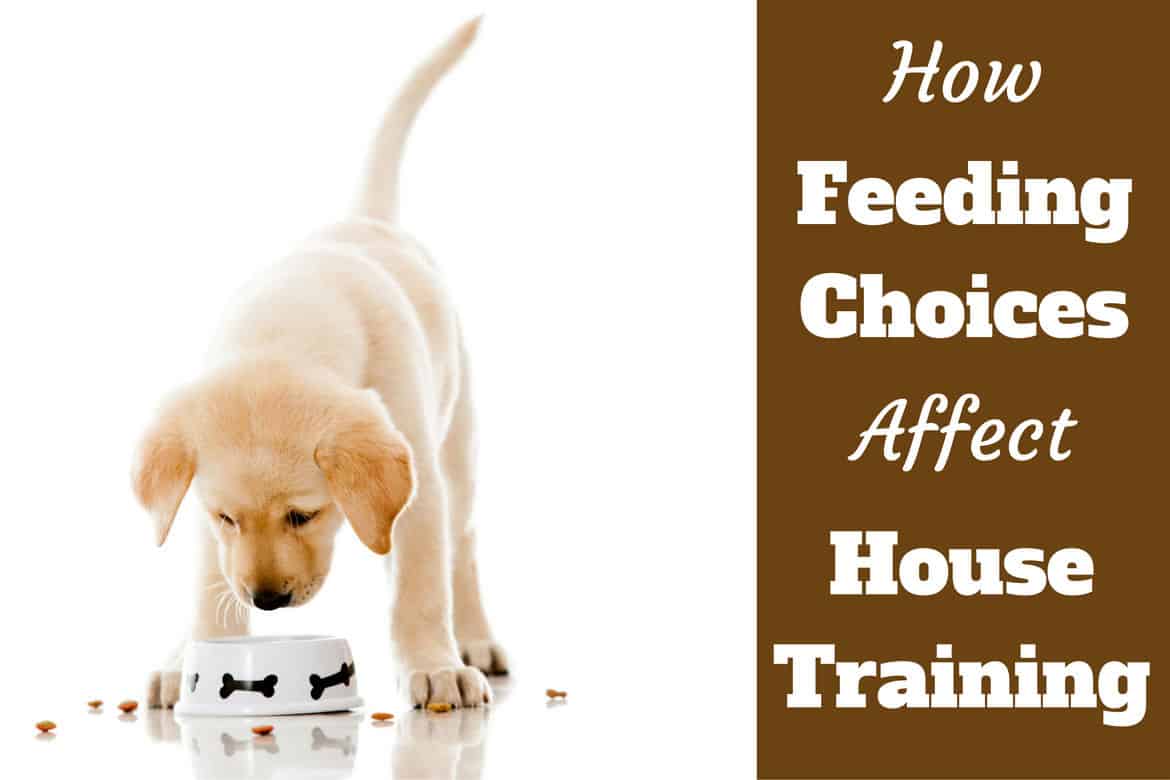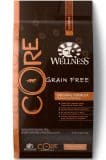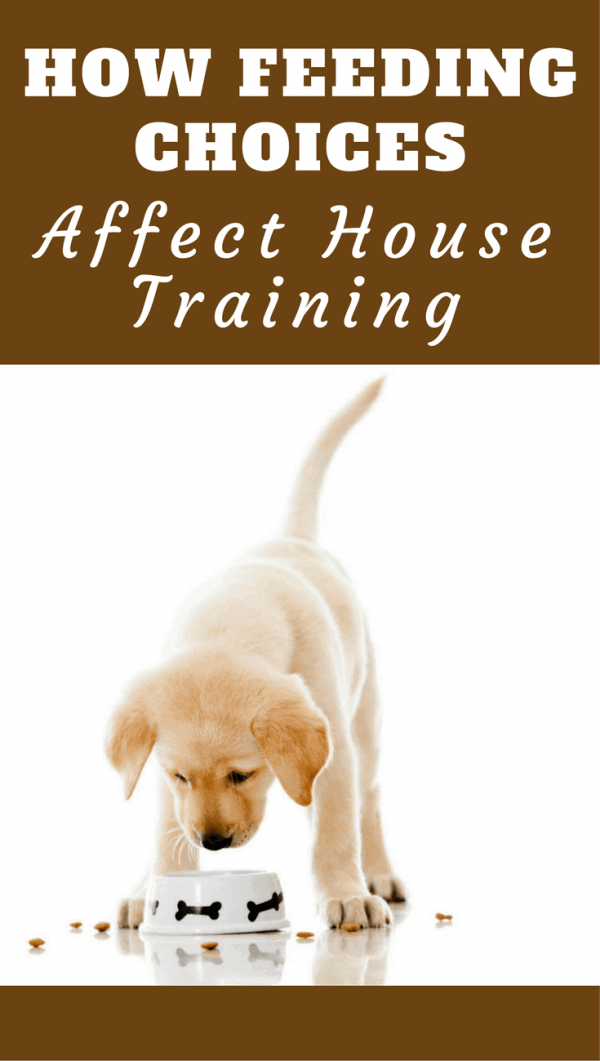This post may contain affiliate links. We may earn money or products from the companies mentioned in this post.

This is the 6th installment in my Ultimate House Training Guide.
Decisions around food play an important part in the house training process, directly affecting the speed of success you will achieve.
I’m sure this isn’t a surprise if you think along the lines of ‘what goes in, must come out’.
In this article I discuss how your choices around what you feed and how you feed your puppy can affect house training in more ways than just one.
Quality Food Has A Massive Impact!
The quality of the food you feed your puppy has a direct influence on how much poop they’ll generate, the consistency of it and how often they will need to eliminate.
Low quality food with lots of filler has a low nutritional value and is hard to digest.
This has a two-fold effect.
Low Quality Food Means More Poop, More Often
With low quality food your puppy will have to eat more to get the nutrients they need, and because cheap filler ingredients are barely digested, a higher proportion will flow right through.
Compare this with a good, high quality food with very little in the way of cheap fillers.
It has a higher nutritional value so you can feed them less in the first place while still meeting their needs. And far more of it gets digested so a lower proportion has to come out the other end.
This means they will eliminate fewer times each day and obviously this makes your life a lot easier.
High Quality Food Helps Learn Bowel Control
Additionally, because your puppy extracts more nutrients from the food and there’s less low quality by-products to pass, their stools will be much firmer and therefore easier for your puppy to hold in.
So higher quality food actually helps your puppy learn bowel control faster. The quicker they learn bowel control, and the stronger their bowel control, the better it is for the house training process.
Our Recommendations For Labrador Puppy Food

With so many brands available and so many of these being questionable quality with poor ingredients, finding the right food for your Labrador puppy can be quite the task.
We’ve written an article explaining why it’s so important to select an appropriate food for the breed that promotes the correct rate of growth, as well as listed 4 of the best foods available, specifically formulated for Labrador puppies to thrive.
You can read that article by clicking here: The Best Puppy Food For Labs.
Feed Puppy On A schedule, They Eliminate On A Schedule
When house training your puppy it’s extremely important to feed them at the same times every day. This is because:
What goes in on a schedule, comes out on a schedule!
If you feed your puppy the same time every day, you can keep a diary and will very quickly pick out a pattern of the times they need to eliminate.
Furthermore, dogs are creatures of habit and they do best when living to schedules and routines.
If you feed, exercise, train and take your puppy to potty at the same times every day, they will learn this schedule and adapt to live and thrive on it.
The benefits?
When you’ve figured out the times they need to eliminate, you can make sure you take them to their bathroom spot at these times.
This cuts down on the mistakes your puppy can make, and gives you more opportunity to praise them for toileting in the right spot.
Also, your puppy learns the schedule and knows when a toilet break is coming. No panic or wondering when they can get outside, they will learn to expect these regular and consistent bathroom visits.
So regular feeding leads to regular elimination times and makes house training easier for both of you.
‘Free Feeding’ Is The Worst Thing You Can Do While House Training!
The opposite to feeding at fixed times on a schedule is the the practice of leaving a bowl of food down to eat whenever they please. This is known as ‘free feeding.’
The problem with this is if they eat at random times, they also poop at random times.
You won’t be able to predict when they need to be at their bathroom spot, they won’t themselves know when it’s coming or learn any schedule and you will forever be cleaning up after them.
Therefore – free feeding? Just don’t do it!
Feed them their 3 or 4 meals at the same times every day, leave it down for 15 minutes only, then remove it until next meal time.
I cannot stress how important this is when house training.
Find A Single Brand Of Dog Food…Then Stick To It!
You need to find a good, high quality brand of dog food that your puppy enjoys and then stick to it.
Sudden changes in your puppy’s diet will almost certainly lead to an upset tummy and diarrhea. And I don’t need to spell out how a case of diarrhea will be bad for the house training process.
The best thing to do is to ask the breeder of your puppy what food they’ve been feeding and to carry on with that particular brand so there’s no change and no disruption.
You might also be interested in:
How To Change Your Puppy’s Food Brand Safely But Quickly
If you do need to change, you must do so slowly.
Change by mixing some of the new brand into the old and increasing the ratio by 10% per day and you will have switched over in 10 days time.
Mix the old and new food to the following ratios for each meal, NOT at different times. Don’t feed one brand in the morning and another at night, you need to mix it up for each meal.
Follow the ratios as follows:
- Day 1: 90% old brand mixed with 10% new brand
- Day 2: 80% old brand mixed with 20% new brand
- Day 3: 70% old brand mixed with 30% new brand
- Day 4: 60% old brand mixed with 40% new brand
- Day 5: 50% old brand mixed with 50% new brand
- Day 6: 40% old brand mixed with 60% new brand
- Day 7: 30% old brand mixed with 70% new brand
- Day 8: 20% old brand mixed with 80% new brand
- Day 9: 10% old brand mixed with 90% new brand
- Day 10: 100% new brand and the switch is complete.
This will be a slow and gentle enough transition to prevent any stomach upsets and give your puppy’s body the time it needs to adapt to the change and prevent diarrhea.
Just remember, a varied diet leads to an upset tummy and a hell of a mess! So stick to one brand of food.
Water Affects How Often A Puppy Needs To Pee
It stands to reason that the more a puppy drinks, the more they have to pee. Just like food, a lot of what goes in just has to come out.
Knowing this, some people limit their puppy’s access to water, thinking this will help with house training.
Should You Limit A Puppy’s Access To Water?
Although I’ve read some house training guides and articles recommending the restriction of access to water, I’m sure it’s not a good idea and have never done this myself.
I always leave a bowl of fresh water out for my Labs to drink from when they feel the need.
Yes, some puppies can drink too much and this will make house training harder. There is that chance. Some puppies just seem to drink and drink and there’s no good reason, they just know no better.
But sometimes there’s a medical reason for this and if they don’t have the opportunity, how will you ever find out? You could be letting a medical condition go unnoticed.
How Much Water Should A Puppy Be Given Each Day?
I suggest in all cases to always provide constant access to water and to monitor their intake, making sure they aren’t gulping down too little or too much.
The majority will regulate their water intake to the times they’re thirsty, which is of course ideal.
But some puppies won’t have this skill until they’ve matured a little. So you have to monitor their water intake for them.
For advice on how much water your puppy should be drinking, how to monitor if they’re drinking too much or too little and how to spot the signs of dehydration, please read the following article: How Much Water Should Your Labrador Drink Each Day?
And please remember that during hot weather or periods of intense exercise or physical exertion, (a regular occurrence often with the extremely energetic Labrador) water requirements can increase quite dramatically so take this into account.
Restrict Access To Water From 2 Hours Before Bed
One piece of advice regarding water that I do follow: During house training, take up your puppies water at least 2 hours before bedtime and make sure you take them to potty right before bed.
This ensures a relatively empty bladder with little flowing through their system, ready for bed time.
If you don’t, you’ll either have to take your puppy out many times during the night, or the chances of your puppy peeing in your home will be dramatically increased.
Once your puppy has matured and is fully house trained, you can leave water out in case they want it during the night.
Just as in humans, the need for water and urine production slows overnight and an adult dog can easily make it through. But a puppy won’t be able to.
Conclusion
What you feed and how you feed your puppy has a HUGE influence on the house training process.
By avoiding cheap foods with low quality fillers and feeding high quality nutritious food instead, your puppy can eat less to receive the same nutrition and as a result will need to poop less often.
The fewer times they need to poop in the months before they’re mature and fully house trained, the less chances they have to make mistakes. The fewer mistakes they make, the less likely pottying in the wrong place becomes a habit. A habit that can be hard to break.
Additionally, feeding on a schedule leads to eliminating on a schedule. So after a short time you’ll be able to predict the times your puppy will need to potty.
This gives you the maximum number of chances possible to get your puppy to their bathroom spot and to praise them heavily and heartily for going in the right place.
Dogs are reward seekers and if they learn that pottying in the right place earns them high praise, they will want to do so more often to earn that praise. This is one of the most effective elements to house training a puppy.
So feed your puppy high quality food at the same times every day. It makes a massive difference.
My Complete House Training Program
This was part 6 in a 12-part series where I’ve tried to provide all the guidance you could possibly ever need and covered everything I can think of for you to successfully house train your puppy or adult dog.
Please see the entire series linked to below:
- Part 1: House Training – The Ultimate Guide
- Part 2: Basic Need To Know Facts Before You Start
- Part 3: The Mindset And Approach You Must Take
- Part 4: House Training Products, Supplies And Equipment You will Need
- Part 5: Accidents Happen: How To Remove Pet Stains And Odors
- Part 6: Feeding Choices Make A Massive Difference
- Part 7: How To Use A Crate To House Train A Puppy
- Part 8: House Training Without A Crate: Constant Supervision
- Part 9: How To Paper Train Your Puppy Or Dog The Easy Way
- Part 10: Umbilical Cord House Training: What is It? How Does It Work?
- Part 11: How To House Train A Puppy
- Part 12: How To House Train An Adult Dog – And Solving Common Issues
Please be aware this page contains affiliate links and Labrador Training HQ receives a small commission if you make a purchase through any such links. This has no effect on the eventual price you pay and we are very grateful for your support.
Save this to Pinterest:

Top Picks For Our Dogs
- BEST PUPPY TOY
We Like: Calmeroos Puppy Toy w/ Heartbeat and Heat Packs - Perfect for new puppies. Helps ease anxiety in their new home. - BEST DOG CHEW
We Like: Bones & Chews Bully Sticks - All of our puppies love to bite, nip, and chew. We love using Bully Sticks to help divert these unwanted behaviors. - BEST DOG TREATS
We Like: Crazy Dog Train Me Treats - One of our favorite treats for training our service dog puppies. - BEST FRESH DOG FOOD
We Like: The Farmer's Dog - A couple months ago we started feeding Raven fresh dog food and she loves it! Get 50% off your first order of The Farmer's Dog.
For a list of all the supplies we get for our new service dog puppies check out our New Puppy Checklist on the PuppyInTraining.com blog.
4 comments
My labrador pup is 3mnths old. She was properly house trained to pass stools n urine in the balcony. But suddenly she has started relieving herself inside the house in newer places.
She also keeps on biting us and chewes up anything in her way. Wat is d solution?
Hi Veena,
The solution is to give her the attention, guidance and training she needs. At 12 weeks, she is still a baby and cannot possibly know how you would like her to behave yet. Keep up with house training, teach her bite inhibition, show her right from wrong and how you would like her to behave, she will be keen to learn but the normal behavior during the puppy stage you’re describing will last many weeks and months yet!
Hi. Your site is really helpful. Thanks. I have an 8-month old chocolate Labrador. Although I feed him on a regular schedule – 7am; 12 noon and 5 pm with the same amount of kibble, he does not have a regular bowel movement. During the day I do give him a few baby carrots, and other small amounts of treats when we are doing some training exercises. Right now I am waiting for a call from the veterarian for surgery – elbow dysplasia so we have not been getting the usual amount of exercise. The schedule for his pee/poop is completely off kilter. He is waking me up at 2am and 3am to go out to do his business. Any tips you have will be appreciated. Thanks
Great series of articles on house training, very comprehensive! I have a follow up question to this one on access to water overnight. During the puppy and house training stage, do you let them drink water at all overnight or simply remove 2 hours before bedtime and return it in the morning? Thank you!